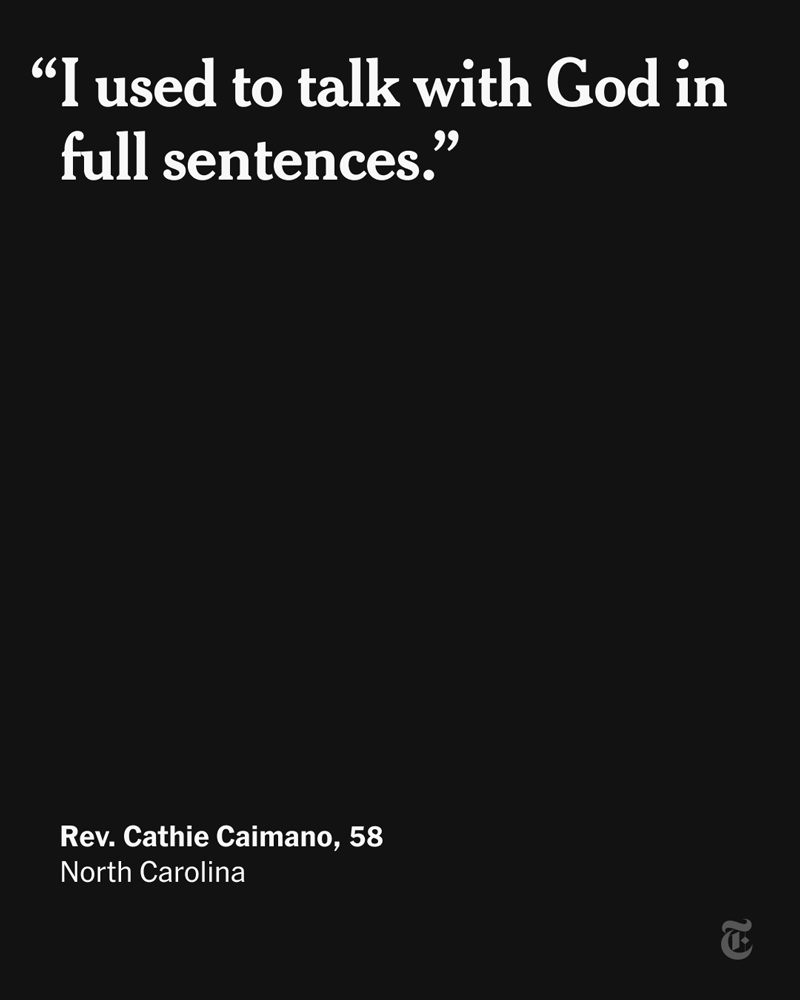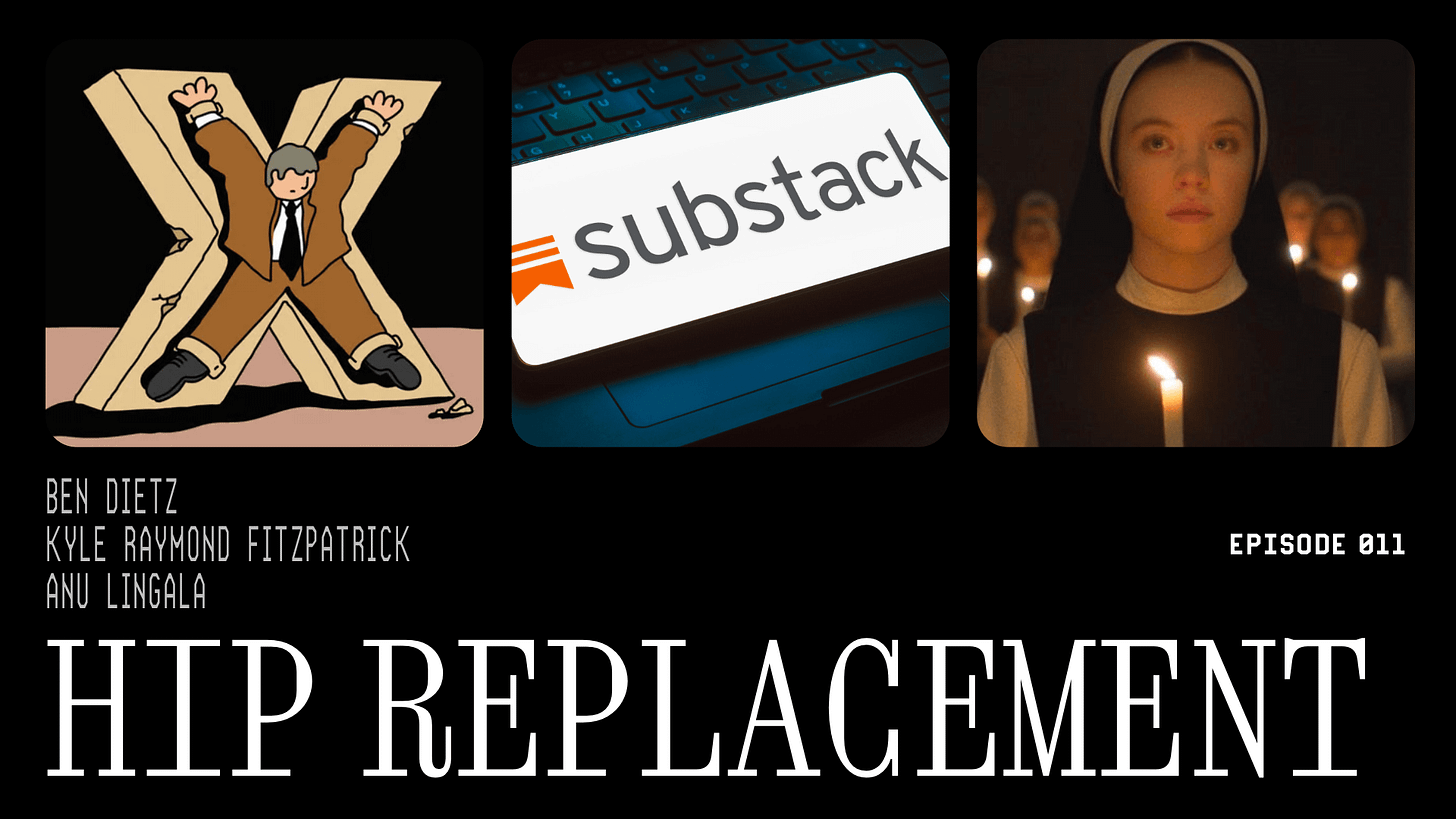A few days ago, I had a fun chat with
and for their podcast. We spoke about the Gen Z religious reawakening near the end, after discussing why Substack isn’t cool.I stand by my take: no tech platform is cool. But I may have a slight revision. I do think it’s sort of cool how writing on here feels like contributing to a broader network of collaborative thinking — sharing perspectives as works-in-progress and building on each others’ ideas. Similar to academia, but in real time. It’d be neat if
offered a way to collect/connect all of these topically interlinked articles in one space for discovery and research. For instance, as I’ve been mulling this topic over, I noticed others have also been contemplating the recent resurgence of religion (, , ).Last month, within the span of one week, the New York Times, The Independent, Vox, and Dazed all published articles exploring an increasing interest in religion. That caught my attention; particularly since it’s not a trend I’d been tracking in any significant way (beyond as a subversive signal of contrarian conservatism and an aesthetic manifestation of Regressive Nostalgia).
I’m less interested in how the aesthetics of Catholicism are being revived, which is not a new phenomenon in fashion and entertainment. I’m more intrigued by reports of increased active engagement with organized religion, particularly amongst young people. This indicates the possibility of a more significant cultural trend with strategic implications that go beyond cross necklaces and gothic lettering.
So, what’s driving this?
My initial inclination was to connect this to my macrotrend of Spiritual Healing, which is influenced by Human drivers like looking inwards, working through personal histories, pursuing self-acceptance, and searching for meaning. An obvious example of this trend would be the astrology boom over the past decade.
Is the reawakening of religion simply the next evolution of this Spiritual Healing? Digging deeper into the signals and the reporting suggests otherwise. It may encompass some ideological similarities to Regressive Nostalgia, but I think it’s more aligned to Collective Kinship, influenced by Sociopolitical drivers:
In her writeup,
notes that, according to data she obtained from GWI, among U.S. consumers ages 16-24:
The share who describe themselves as “very religious” is up 27%
And, at the same time…
Interest in astrology is down 18%
These figures suggest a significant shift in what sorts of spiritual practices young people are turning towards.
What does organized religion offer that pop spirituality doesn’t?
Perhaps — community, and higher purpose.1
A caveat here: the GWI data seems to contradict other sources.
This Pew Research survey from fall 2024 found that between 2017 and 2024, belief in astrology amongst people ages 18-29 went up by 1 percentage point — minuscule, but notably nothing close to GWI’s reported 18% decline. Pew states: “Belief in astrology among these demographic subgroups has changed little since we asked this question in 2017.”
When it comes to religion, a February 2025 Pew Research headline confirms that the decline of Christianity in the U.S. has notably slowed. But they also clearly state that young people remain “far less religious than older adults” and “no recent birth cohort has become more religious as it has aged.”
Pew doesn’t have comparative prior data for the 18-24 cohort, since they only surveyed adults, so we can’t see how these numbers may have changed over time. But just last year,
Regardless of the specifics of the data,2 the broader cultural discourse remains relevant. When reading the several recent articles on this subject, the most interesting and insightful aspects are the qualitative sentiments expressed by interviewees:
Despite rising participation in alternative spiritual practices over the past decade, many Americans still feel unfulfilled and “simply haven’t found a satisfying alternative to religion.”

I think the recent New York Times article by Lauren Jackson provides the most comprehensive overview of this cultural tension; although I have issues with some of the correlations emphasized, and I feel it overlooks a couple of key insights. But Jackson has spent the past year reporting on this topic, and she shares some valuable perspective on the why behind Pew’s recent finding that the decline of Christianity in the U.S. has slowed:
Religion provides what sociologists call the “three B’s”: belief, belonging and behaviors. It offers beliefs that supply answers to the tough questions of life. It gives people a place they feel they belong, a community where they are known. And it tells them how to behave, or at least what tenets should guide their action. Religious institutions have spent millenniums getting really good at offering these benefits to people.
I think these “three B’s” provide a great framework to dissect the sustained appeal of organized religion and extract some useful insights.
Belief: Hoping for Hope
It’s unsurprising that people would be drawn to religion because it offers comfort and hope — the calming solace that everything happens for a reason, and it will all work out for the best. For millennia, a sense of faith has helped to mentally carry people through natural disasters, famine, and war. In her article, Jackson references a theory proposed by some political scientists:
“Religion flourishes in times of ‘existential insecurity,’ they say, and withers in times of peace and bounty. Other scholars say this may be particularly true in the United States compared with other wealthy countries with stronger social safety nets….In a country where most people are pessimistic about the future and don’t trust the government, where hope is hard to come by, people are longing to believe in something.”
This tracks, since it’s been feeling like the world is on fire for a while now. But these reasons are analogous to those that led to the rise of alternative spiritual practices over the past decade. Of the “three B’s,” belief is one that broader spirituality is best equipped to provide — though perhaps not as effectively as blind faith.
Belonging: Embracing Community
Not new news: Gen Z and Millennials are lonely and desperate for community. The Pew research suggests that the pandemic experience of isolation may have renewed people’s existing faith, leading to lower numbers leaving organized religion in recent years. As I mentioned previously, contemporary western interpretations of alternative spirituality skew towards individualism. In contrast, organized religion offers built-in community. But so do, purportedly, run clubs and chess clubs and supper clubs. So why church?
Well, “people in church don’t get to reject you,” which is certainly unique. It’s rare to find a space where unconditional acceptance is an expectation.
But also, are you really having deep existential conversations about the purpose of life with your new workout buddy? I think not. Jackson speculates:
“People also want to belong to richer, more robust communities, ones that wrestle with hard questions about how to live. They’re looking to heady concepts — confession, atonement, forgiveness, grace and redemption — for answers.”
The Gender Divide
This is where things get a bit interesting. Anecdotal evidence at some churches suggest that young men are attending services more often than women, and that women are leaving religion at higher rates.
Both this New York Times article and this Slate piece reference 2023 data from the Survey Center on American Life as evidence of a sharp and unexpected reversal of the norm (for decades prior, women have been significantly more religious than men). The recent Pew research argues the shift is more subtle: women remain more religious than men, but the gap is narrowing.
Though less drastic than the headlines suggest, this data still gives credence to the idea that young men may be turning to religion, or remaining attached to the religion they were raised with, in parallel to their increased alignment with conservative values. Meanwhile, young women may be more inclined than previous generations to leave their religion, often due to misalignment with their liberal values. Essentially, the growing political gender gap may mirror a growing religious gender gap.
Vox asks, “is politics driving these changes in religious behavior and belief? Or is religion driving stronger political beliefs?” I’d argue, neither of these is the driver. Really, the gap is rooted in disparate social values.
But it’s also interesting to specifically consider religiousness among men in relation to Belonging. While young people are well-known to be lonely overall, new evidence confirms that men are faring worse. A recent Gallup poll suggests that Gen Z and Millennial men in America are some of the loneliest in the world: 25% report feeling lonely (versus 18% of women).
Most analysis of the ‘male loneliness epidemic’ points to the fact that “a lack of friendships, particularly intimate ones, is much more common to men.” Recent data from Pew corroborates this: only 38% of men (of all ages) say “they’d be extremely or very likely to turn to a friend” for support or social connection, compared to 54% of women. It’s obvious why the built-in community offered by organized religion may be attractive to lonely young men, as vividly illustrated by this anecdote from The New York Times:
The camaraderie was easy to see after the Sunday service at Grace this month. A circle of young men lingered in the sanctuary, talking and laughing.
“There’s so many genuinely good guys that are just literally always here for you,” said Andrew Parks, who has attended Grace for several years.
Behaviors: Pursuing Purpose
This might be the most difficult of the “three B’s” to replicate effectively outside of organized religion: the idea that your behaviors should align with a higher purpose; the guidance of a moral code. While the law offers rules, and parents teach values, there’s nothing quite like a fear of God.
The sense of higher purpose offered by religious faith is understandably attractive, but increasingly misaligned. In the modern era, ideas of morality have evolved, and people may find that their sociopolitical values are at odds with those of most religions. In the same article I quoted above, describing men finding community at church, a young woman is quoted saying:
“I can’t go to a place of worship and know that the person next to me thinks that gay people are going to burn in hell.”
A recent Dazed article digs into how some young religious people are managing this cognitive dissonance (and there’s a UK version too):
Blue-Waverly, a 27-year-old in New York, has witnessed “many peers” become interested in Christianity in recent years, not because of Trump but in spite of him and his administration.
These individuals reference liberal stances on issues like immigration and Palestine, and discuss how religion can, perhaps unexpectedly, “fuel a strong sense of progressive activism rooted in compassion, justice and solidarity.”
Whether the sense of purpose imbued by religion translates to more conservative or liberal values, I think the key takeaway is that many young people are actively seeking a positive universal goal to contribute towards: a reason for being.
Strategic Implications
It may seem like a stretch, but every trend has takeaways for brands. Obviously, most companies should avoid wandering into overtly religious realms. But I think there are some key insights above that are worth highlighting.
The fact that people are turning to religion as a way to find belonging reaffirms the buzzword of the past year — “community” may be indeed a potent opportunity space for brands. But as
explains in her post, The Community Delusion, “almost no one’s doing it right.”“Community” has become a shield used to justify vague strategies, sentimental copy, and low-lift engagement efforts. It’s become a way to gesture at intimacy without delivering on it and to claim moral high ground without accountability.
The recently trending hobby-based or brand-led “communities” are too superficial and ineffective in satisfying consumers’ desire for deep, intimate connection. Brands catering to men, in particular, have both a massive opportunity and complex challenge in finding ways to connect with young men, and help them connect with each other more authentically, without stoking their disillusionment.
Meanwhile, the sustained appeal of aligning with a greater purpose offers an opportunity for brands targeting to women and/or broader audiences to attain favor through values-driven behaviors. Taking risks to prove dedication to shared beliefs can build trust over time. A lot of brands have walked away from purpose-oriented strategies in the midst of recent sociopolitical turbulence, deserting a once-crowded space. It’s easier than ever to make a statement, but it needs to come from the heart. What do your customers actually care about?
Specifically, western adaptations of astrology. Ancient spiritual practices often involved communal gatherings and rituals, and typically aimed to connect people to a greater universal purpose. However, most contemporary approaches tend to focus on individualism and capitalistic success (i.e. manifesting money).
I am definitely not a data expert by any stretch of the imagination. If anyone else wants to sort through the conflicting statistics in these reports, would love that.












Great piece! Enjoyed reading this one!
Refreshing to see a thoughtful and informed take on this - I do feel people love to take any scrap of insight or statistic to make Gen Z out as freaks.
Generational antagonism aside, as a researcher I was curious about the discrepancy in statistics but couldn't find info about the question or dataset from that GWI source. I would be looking to see if the questioning subtly or overtly biases responses to a particular side.